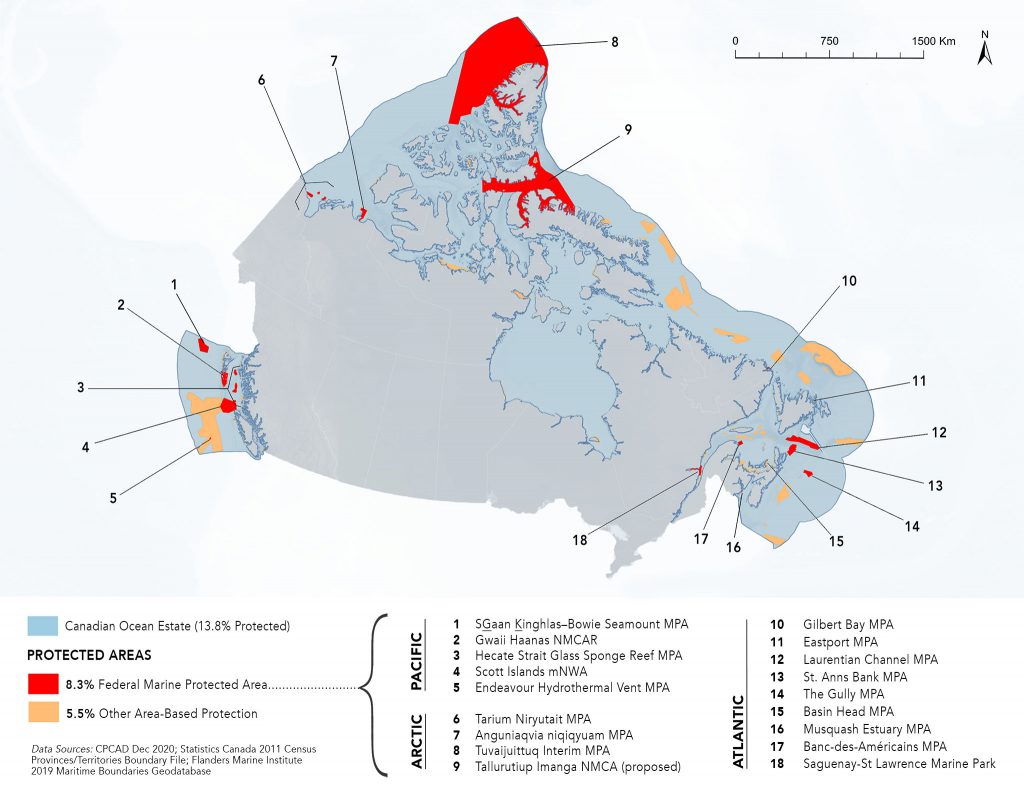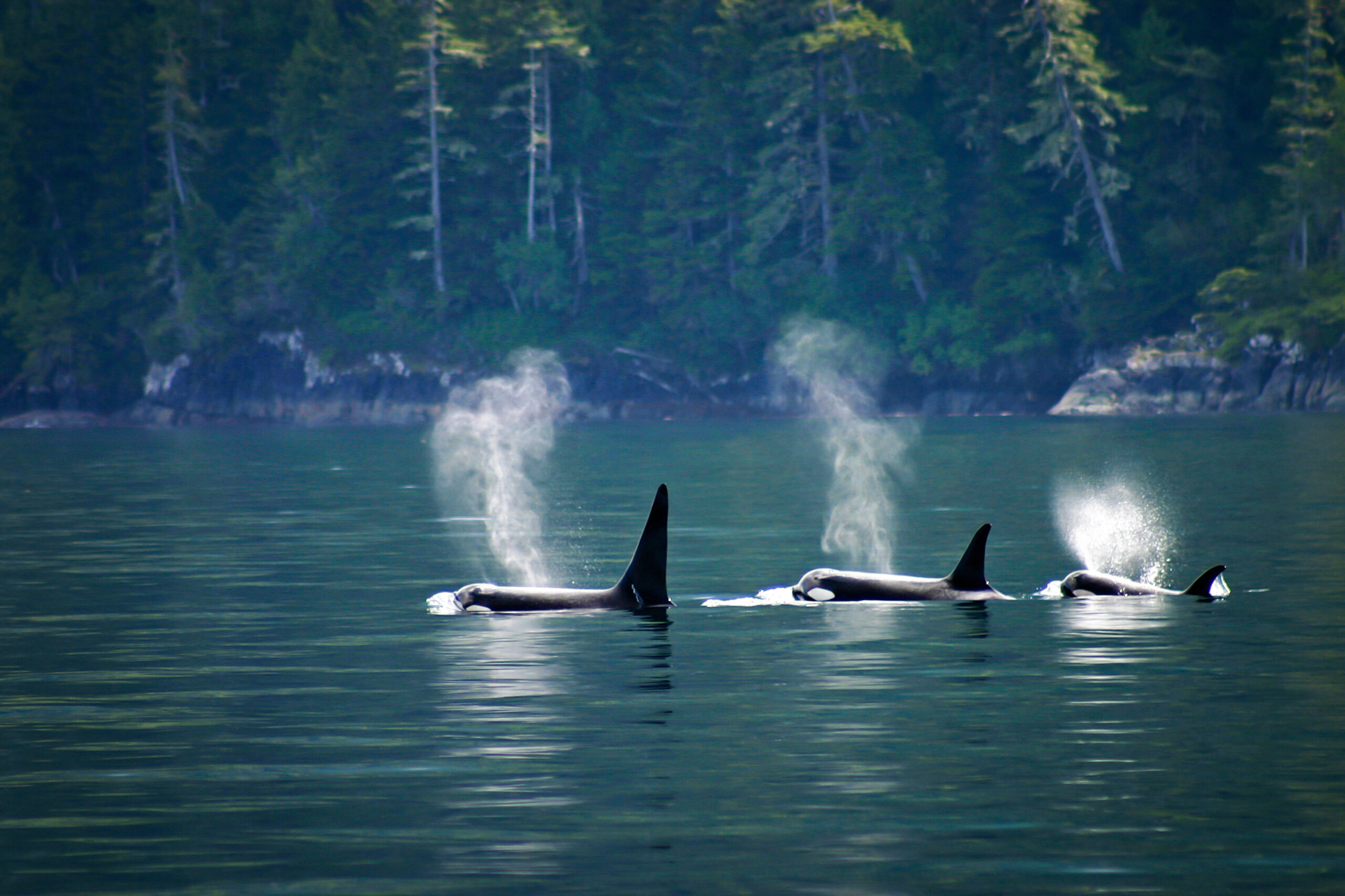Marine Protected Areas (MPAs) can protect ocean habitats from harmful activities, allowing marine ecosystems and species to recover and better withstand the impacts of climate change. Canada has committed to protecting 25% of its ocean by 2025, working towards protecting 30% by 2030. Learn more about Canada’s marine protected areas by visiting our Interactive MPA Dashboard and how we can meet the ocean protection targets in our 2021 Ocean Report.
Join the movement to protect 30% of land and ocean in Canada by 2030.

Marine Protected Area (MPAs)
Areas of the ocean where industrial activities that threaten or harm marine ecosystems are prohibited. MPAs offer an effective way to address multiple threats to a variety of species, creating sanctuaries for marine ecosystems to recover and for species to thrive. An MPA must have a clearly defined boundary and be set aside by law (or other means) for long-term protection.
MPA Networks
A group of marine protected areas that are designed to function together for greater, more widespread benefit. Networks protect the full range of species and ecosystems in a large area and allow species to move between protected areas.
MPA networks ensure that entire ecosystems are considered, and allow for a range of distances between MPAs to accommodate limited human use in surrounding waters.
Marine Spatial Planning (MSP)
A process in which coastal communities and ocean users discuss how ocean and coastal areas are used, and create a map and plan for sustainable use.
MSP should involve identifying priority areas that need to be protected and addressing human activities, such as fishing, shipping, oil and gas development, tourism and recreation. Cultural sites and pollution sources should also be taken into consideration in the planning process.
Other Effective Conservation Measures (OECMs)
Areas that do not have the full legal protection of an MPA. Harmful activities are prohibited through other management measures, such as through military-secure areas. In Canada, most OECMs are fishing closures, which have their limitations.
Canada has the longest coastline in the world, which spans the Arctic, Atlantic and Pacific Oceans, as well as one of the largest ocean territories. Canada’s ocean is home to an incredibly diverse array of species – from great whales and sharks to deep-sea corals and sponges. It is, however, under extreme pressure from industrial activities like oil and gas development, mining, dumping, commercial shipping and bottom trawling. Canada’s marine ecosystems are also being impacted by climate change.
Marine Protected Areas can provide safe spaces in which marine ecosystems can recover, thrive and adapt to a changing climate. MPAs can also protect culturally important features, such as Indigenous clam gardens, and allow marine ecosystems to help mitigate the impacts of climate change through carbon storage. In addition, MPAs support sustainable fisheries and provide new, long-term economic opportunities. The most effective MPAs have strong protections and are part of a network that allows species to move between protected areas.
Currently, around 13% of Canada’s ocean is being counted towards the country’s Marine Protected Areas and Other Effective Conservation Measures (OECMs). Canada has committed to protecting 25% of its ocean by 2025, working towards 30% by 2030, and CPAWS is calling on Canada to protect at least 50% of its ocean. These targets are essential for the long-term resilience of the planet. We are working with Indigenous governments and partners to ensure that Canada’s MPAs are protected and managed effectively.
What CPAWS is Doing
CPAWS has been advocating for Marine Protected Areas in Canada for more than 20 years. Our mission for Canada’s ocean is simple: more MPAs, better MPAs and MPAs in the right places.
More Marine Protected Areas
CPAWS works with governmental, conservation and industry partners to improve protection standards for Canada’s MPAs. We help Canadians to actively engage in public consultations and advocate for strong protection in MPAs.
For more information, read our submission to the National Advisory Panel on MPA Standards.
Successes
- 2018 – Canada’s Oceans Act and the Canada Petroleum Act updated to provide increased marine protection, including interim protections while MPA sites are being designated. These updates enable the Department of Fisheries and Oceans to more effectively prohibit oil and gas development within MPAs
- 2019 – After years of advocacy work, the Government of Canada announced minimum protection standards for all new federally designated MPAs. The minimum protection standards prohibit bottom trawling, oil and gas, mining and dumping. CPAWS will continue to push for the minimum standards to be reflected in policy or legislation
Better Marine Protected Areas
CPAWS works with governmental, conservation and industry partners to improve protection standards for Canada’s MPAs. We help Canadians to actively engage in public consultations and advocate for strong protection in MPAs.
For more information, read our submission to the National Advisory Panel on MPA Standards.
Successes
- 2018 – Canada’s Oceans Act and the Canada Petroleum Act updated to provide increased marine protection, including interim protections while MPA sites are being designated. These updates enable the Department of Fisheries and Oceans to more effectively prohibit oil and gas development within MPAs
- 2019 – After years of advocacy work, the Government of Canada announced minimum protection standards for all new federally designated MPAs. The minimum protection standards prohibit bottom trawling, oil and gas, mining and dumping. CPAWS will continue to push for the minimum standards to be reflected in policy or legislation
MPAs in the Right Places
CPAWS works with scientists, conservation partners and communities to identify candidate areas for new MPAs and areas in need of protection. We also work with decision-makers, communities and stakeholders to develop proposals for protection – this work involves identifying appropriate legal tools and required protection measures.
Visit our regional chapter websites to learn more about ocean work happening across the country.
NEW IMPAC5 DATES: 03-09 February-2023! Click for more details.
Join us in Vancouver in February 2023 for the 5th International Marine Protected Areas Congress (IMPAC5), where we will come together to protect the ocean.
CPAWS joins the Government of Canada, IUCN, and Host First Nations as a proud key partner of IMPAC5. Over 3,000 diverse marine conservation professionals from around the world are expected to attend the week-long global forum to inform, inspire, and act on marine protected areas in Canada and internationally.
CPAWS will be sharing more details as they are confirmed. Follow IMPAC5 on Twitter, Facebook, Instagram and LinkedIn, and visit www.impac5.ca for more information!











